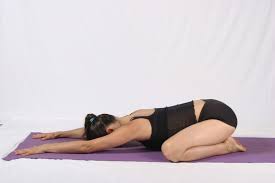

Fold the blankets so the rounded edge is near the legs of the chair.

14 It calms the nervous system and frees the brain of stress, leaving you feeling relaxed. If you are trying to ease pain and tension from the front of your head, this asana can help. Supported Ardha Halasana Or Half Plow Pose Breathe in as you raise your torso up, pulling your tailbone into the pelvis.ĥ. To exit the pose, lift your torso from your thighs gently and straighten your elbows. When you exhale, release more into the forward bend. Allow your front torso to rise and lengthen a little each time you breathe in.Feel your lower belly graze your thighs, followed by your upper belly, and then your ribs. If you are holding a strap, then loosen your hold, move your hands forward and keep your arms long when you do this. Your elbows must bend out to your sides and lift up off the floor. Gently ease into the forward bend, lengthening your torso and keeping the head raised.If you cannot reach your feet with the hands, use a strap looped around the feet and hold this instead. Breathe in as you lean forward from your hip, arms fully extended, elbows straight, hands on the sides of your feet, and your thumbs resting on your soles.Also, press your palms and fingertips into the floor and raise your sternum up to the ceiling. The tops of your thighs must be turned in ever so slightly and pressed into the floor. Rock on each buttock by turn, pulling away from the other sitting bone as you do so.

Sit on the ground on a mat or folded blanket to support the buttocks, with your legs extended in front.You can make use of a strap to help you with this pose if needed. 11 It also eases stress, relieves headaches, and calms the brain. This asana, like the janu sirsana, helps calm excited nerves, slows the release of hormones from both the adrenal and pituitary and glands. Come up slowly and repeat to the other side.Ĥ. Get the length from your spine and gently ease forward. Do not bring your head to the knee as this will cause your back to arch.Your straight leg can curve in slightly but should remain straight. Exhale, moving your pelvis forward so the spine can move up a little too.Now place the hands on the foot (or ankle or knees, whichever you can reach) of the straight leg.Place your arms behind your back and as you exhale, use them to raise your spine upward.The foot of this leg should graze the inner thigh of the straight leg. Bend one knee to your chest while the other remains extended.Sit down on a mat with your legs together and extended in front of you, your spine straight, hands resting lightly on the mat near your upper thighs.

2 In one study of patients who faced a migraine without aura, yoga therapy for 3 months was found to help reduce the severity of the migraine and the pain, besides reducing headache frequency. What’s more, researchers suggest that due to this effect, it could possibly help reduce the dosage of medication you need in conventional care, as well as your chances of side effects from those drugs. Yoga, when added to the conventional care for such headaches, can help not only reduce the severity of an attack but also even cut down their frequency. You also need to avoid possible triggers. Being a chronic disorder, migraines need constant care and management through medicines and lifestyle changes. This can often wreak havoc on your quality of life. Migraines, a neurological disease, can result in symptoms like nausea, vomiting, flushing, pallor, and diarrhea during acute migraine episodes. Yoga Helps Reduce Episodes And Intensity Of Migraine While mainstream medication offers some solutions, yoga may be an alternative way to migraine relief. 1 So you’d be forgiven for wanting some way, any way, to rid yourself of the pain and other symptoms that go with this malady. In fact, it is the world’s sixth leading cause of years lost due to disability. The blinding pain of a migraine can bring anyone to their knees.


 0 kommentar(er)
0 kommentar(er)
